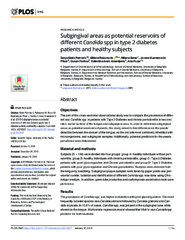Приказ основних података о документу
Subgingival areas as potential reservoirs of different Candida spp in type 2 diabetes patients and healthy subjects
| dc.creator | Matić-Petrović, Sanja | |
| dc.creator | Radunović, Milena | |
| dc.creator | Barać, Milena | |
| dc.creator | Kuzmanović-Pfićer, Jovana | |
| dc.creator | Pavlica, Dušan | |
| dc.creator | Arsić-Arsenijević, Valentina | |
| dc.creator | Pucar, Ana | |
| dc.date.accessioned | 2020-07-02T13:26:41Z | |
| dc.date.available | 2020-07-02T13:26:41Z | |
| dc.date.issued | 2019 | |
| dc.identifier.issn | 1932-6203 | |
| dc.identifier.uri | https://smile.stomf.bg.ac.rs/handle/123456789/2463 | |
| dc.description.abstract | Objectives The aim of this cross-sectional observational study was to compare the prevalence of different oral Candida spp. in patients with Type 2 Diabetes and chronic periodontitis in two oral sites: dorsal surface of the tongue and subgingival area. In order to determine subgingival areas as potential reservoirs of yeasts, this study aimed to find differences in the yeasts' detection between the dorsum of the tongue, as the oral site most commonly inhabited with microorganisms, and subgingival samples. Additionally, potential predictors for the yeasts prevalence were determined. Material and methods Subjects (N = 146) were divided into four groups: group A-healthy individuals without periodontitis, group B-healthy individuals with chronic periodontitis, group C-Type 2 Diabetes patients with good glycoregulation and Chronic periodontitis and group D-Type 2 Diabetes patients with poor glycoregulation and Chronic periodontitis. Samples were obtained from the tongue by swabbing. Subgingival plaque samples were taken by paper points and periodontal curette. Isolation and identification of different Candida spp. was done using ChromAgar medium. In addition, germ-tube production and carbohydrate assimilation tests were performed. Results The prevalence of Candida spp. was higher in diabetics with poor glycoregulation. The most frequently isolated species was Candida albicans followed by Candida glabrata and Candida tropicalis. In 15.6% of cases, Candida spp. was present in the subgingival area while absent on the tongue. Multivariate regression model showed that HbA1c was Candida spp. predictor for both locations. Conclusions Our results confirmed that there are Candida spp. carriers among subjects with clinically healthy oral mucosa. Also, this study identified subgingival areas as potential reservoirs of these pathogenic species. Glycoregulation has been recognized as a positive predictor factor of Candida spp. | en |
| dc.publisher | Public Library Science, San Francisco | |
| dc.relation | info:eu-repo/grantAgreement/MESTD/Integrated and Interdisciplinary Research (IIR or III)/41008/RS// | |
| dc.relation | info:eu-repo/grantAgreement/MESTD/Integrated and Interdisciplinary Research (IIR or III)/41027/RS// | |
| dc.rights | openAccess | |
| dc.rights.uri | https://creativecommons.org/licenses/by/4.0/ | |
| dc.source | PLoS One | |
| dc.title | Subgingival areas as potential reservoirs of different Candida spp in type 2 diabetes patients and healthy subjects | en |
| dc.type | article | |
| dc.rights.license | BY | |
| dcterms.abstract | Кузмановић-Пфићер, Јована; Пуцар, Aна; Aрсић-Aрсенијевић, Валентина; Радуновић, Милена; Павлица, Душан; Матић-Петровић, Сања; Бараћ, Милена; | |
| dc.citation.volume | 14 | |
| dc.citation.issue | 1 | |
| dc.citation.other | 14(1): - | |
| dc.citation.rank | M22 | |
| dc.identifier.wos | 000455483000102 | |
| dc.identifier.doi | 10.1371/journal.pone.0210527 | |
| dc.identifier.pmid | 30629672 | |
| dc.identifier.scopus | 2-s2.0-85059829618 | |
| dc.identifier.fulltext | https://smile.stomf.bg.ac.rs/bitstream/id/989/2458.pdf | |
| dc.type.version | publishedVersion |


